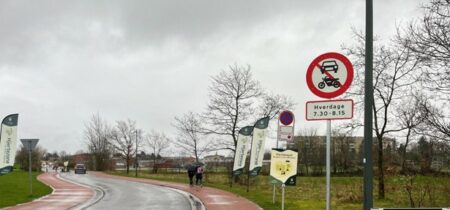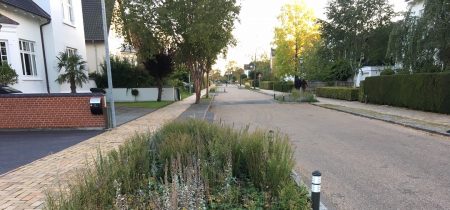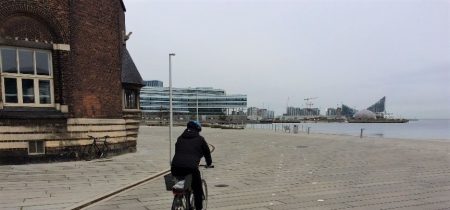Two-way cycle tracks
Two-way cycle tracks can either be placed along the road or with their own layout away from the road. There are binding rules for their placement along the roads. The design of track termination and intersections is particularly important.
By Troels Andersen, Odense municipality
Two-way cycle tracks can be installed through recreational areas, as shortcuts between cities, as a cycle track system in residential areas, or along main roads with few intersections.
Two-way cycle tracks often function as a shared path for walkers and cyclists. Two-way cycle tracks have an independent cross profile, independent of nearby roads.
There are two main types of two-way cycle tracks:
- Two-way track along the road.
- Track with its own layout through green spaces and residential areas, etc.
Two-way cycle tracks along the road
Two-way cycle tracks along the road should only be established after a safety assessment of conditions in the area in question. The assessment should include options for other solutions for light road users. Two-way cycle tracks should only be established as the exception, but they may be a fine solution in open country if the school, playing field, etc. is outside the town and a two-way cycle track would make it possible to get there without crossing the road.

- Accidents with cyclists coming from the wrong direction of travel often occur in this type of signalized intersection with two-way cycle tracks. Drivers overlook cyclists, and cyclists don’t always follow the rules. Photo Troels Andersen
Two-way cycle tracks mean a wider track for the individual cyclist, but are not as safe as one-way tracks at intersections and driveways and exits.
Two way cycle tracks are cheaper to install than one-way cycle tracks.
Two-way cycle tracks along the road should not be installed where there are many side roads or entrances and exits across the track, (for example, in cities). Safety issues arise when a two-way cycle track crosses a side road because drivers often overlook cyclists coming from the wrong direction.
The solution in this situation is to install a one-way cycle track on each side of the road if the road is wide enough.
Two-way cycle tracks in rural areas should be installed when there is dense motor traffic and enough space, for example along a highway or a heavily trafficked main road. From the point of view of traffic safety it’s often best to place the two-way cycle track on the side of the road where there are fewest side roads and entrances and exits.
On the other hand, if many cyclists use the side roads it may be safer to place the two-way cycle track on the same side as the side roads. The termination of a two-way cycle track should be designed in relation to the need for traffic islands at crossings, etc.
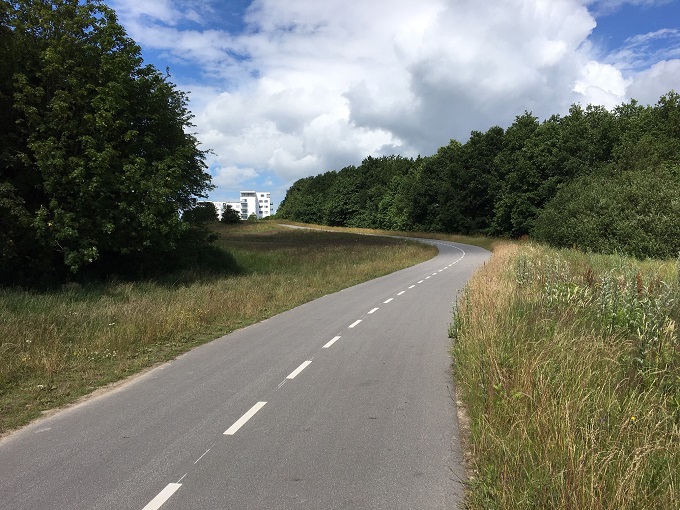
- This track with its own layout is a harmonious component of the landscape. Photo Troels Andersen
Cycle tracks with their own layout
When cycles tracks have their own layout it means they are placed at a distance from roads with motor traffic. Tracks that lead through recreational or residential areas offer shorter, safer and more secure routes where the focus is on cyclist needs. In residential areas the tracks offer children and the elderly in particular excellent cycling conditions. Pedestrians can also use the tracks.
A cycle track with its own layout can be used by small children without adult supervision if the track doesn’t cross major roads on the same level. The tracks can often be used to offer cyclists shortcuts between key destinations such as schools and shopping. Tracks with their own layout can be integrated into a master traffic plan for the separation of traffic modes where motor traffic rather than bicycle traffic is assigned the deviation route. Tracks with their own layout can also be installed to promote cycling tourism and recreational cycling.
A track with its own layout occasionally means a delay for cyclists. The cyclist often has the duty to yield where the track intersects a road, which negatively affects cyclist accessibility. However, the right of way may be changed in the cyclist’s favour.

- The cycle track crosses the road on a raised surface where cars yield to cyclists.
Tracks can have a lower curve radius in both horizontal and vertical curves than roads.
As an anti-crime measure to enhance security after dark, care must be taken to ensure that tracks with their own layout have light and air and are visible from the road or nearby residences. This applies particularly to underpasses.
Cross profile
The track should be dimensioned so two cyclists with bicycle trailers can pass each other. If walkers need space as well, the width should be additionally increased. A two-way shared space cycle track should be at least 3 m wide, and a two-way cycle track with an adjoining separate pedestrian area should be at least 2.5 m wide. The width of the track is crucial for cycling comfort and accessibility. The given widths enable two cyclists to ride next to each other and carry on a conversation.
In urban areas the verge between the traffic lane and the two-way track must be min. 1.0 m wide.
Along main roads the verge should be min. 1.5 m wide. A verge width of 3 m is recommended along major roads. Guardrails should be installed at narrower widths. If the two way cycle track is closer to the highway or the expressway than approx. 15 m, a guardrail should be installed between the track and the road.
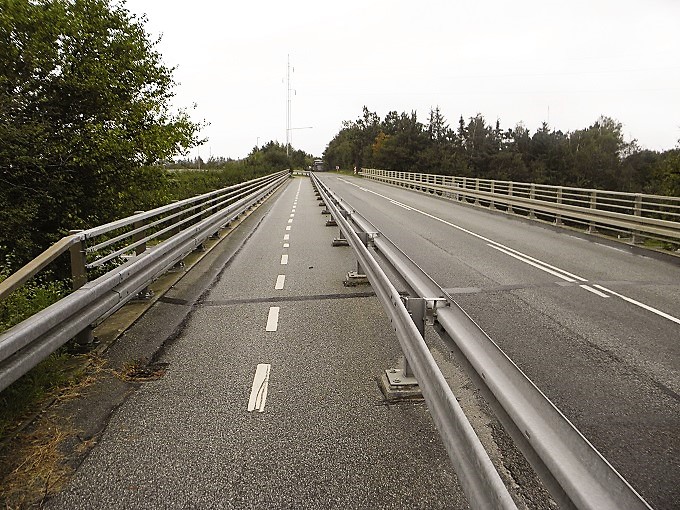
- Two-way cycle track along the road segregated by a guardrail. Photo Troels Andersen
Horizontal and vertical radius
On roads with two-way traffic, curves must be designed with sufficient stopping sight distance so cyclists coming from opposite directions can see each other in time to forestall dangerous situations. This also applies to curves at tunnels, at intersections with other tracks, etc.
If there is moped or scooter traffic on the track, the curve radius should be dimensioned according to their stopping sight distance. This also applies to speed pedelecs.
If the appropriate stopping sight distance cannot be achieved, the two directions must be separated by a median strip, verge, etc. A cheap solution is a road marking between the two directions. In Holland a beveled kerb in the middle is occasionally installed.
Both cyclists and moped drivers should be able to take any horizontal curve (to the right or the left) at 30 km/h. When the horizontal curve is taken together with a vertical curve it may be necessary to dimension for higher speeds for both cyclists and moped drivers so they don’t swerve out of control in the curve. When the horizontal radius is less than 50 m there must be a slope towards the curve’s center.
As a minimum there must be at least stopping sight distance in vertical curves (up and down) on two-way cycle tracks. Cycle tracks with moped traffic should be dimensioned according to the moped.
Gradients
Cyclists need to supply the energy necessary to propel the bicycle forward themselves. Steep inclines on the track significantly affect the number of cyclists. In addition cyclist safety is also linked to the steepness of the cycle track incline. Consequently planners must operate with maximum gradients.
The energy expenditure necessary to go uphill places limits on the length of the ascent as well as the gradient. Precisely in the case of cycle tracks with their own layout it’s economically feasible to adjust the track’s longitudinal slope so it doesn’t become a problem for cyclists. It’s best if the slope is greater at the bottom of the hill than at the top.
Cyclist safety is reduced if steep downhill inclines are combined with sharp horizontal curves. At a gradient of 50% the dimensioning speed should be 40 km/h and at a gradient of 30% it should be 36 km/h. Consequently great care must be given to designing tracks around tunnels and bridges.
Gradient Maximum length
50% 50 m
45% 100 m
40% 200 m
35% 300m
30% 500m
Intersections between cycle tracks
Intersections between tracks have hitherto been a neglected area in Denmark. It’s important that there is a good stopping sight distance so cyclists and moped drivers can clearly see cross traffic. Planting and the like along the track should be continually cut down so the field of vision is not impaired. It’s also important to establish clear right of way rules in areas with many cyclists, and when it’s not possible to achieve an acceptable field of vision.
At intersections where speeds are too great, either because the intersection is at the bottom of a hill or because cyclists don’t follow the duty to give way rules, traffic calming measures for cyclists can be installed. Crossings with speed bumps or ramps are a good example. Right of way tracks can be designed with a slope up to the main track. Since cycle tracks are established in order to improve bicycle traffic conditions, traffic calming measures should only be installed if there are actual issues.
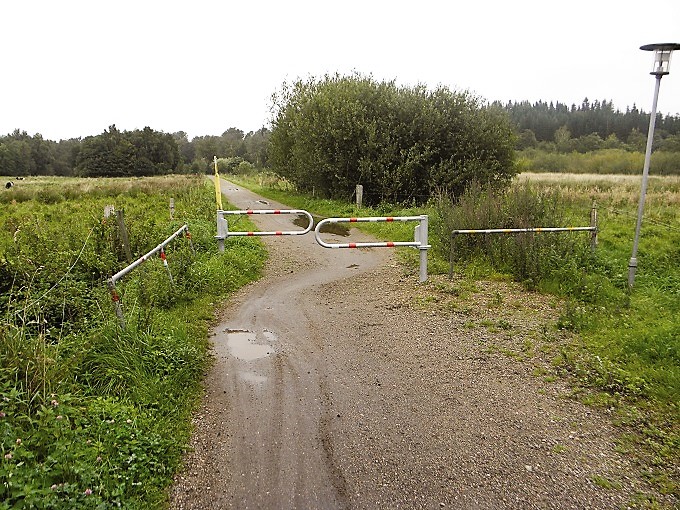
- Cycle track barriers have been set up to reduce moped speeds.
Intersections between cycle tracks and roads
At intersections between tracks and roads and at the termination of a cycle track, conflicts arise between cars and bicycles. It’s especially important that the road user with the duty to yield is aware of the conflict. A clear, uniform field of vision on both sides is important.
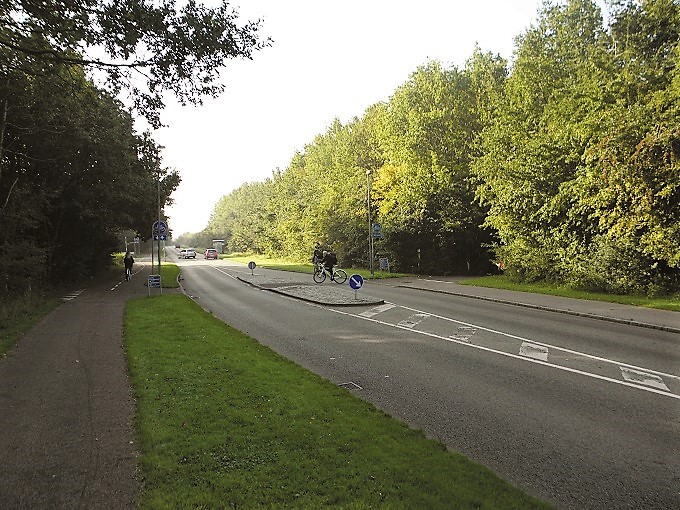
- The transition from one-way cycle track to two-way track is solved by a traffic island that leads cyclists safely across the road. Photo Troels Andersen
When cars have the duty to yield, physical traffic calming measures and signalization are necessary to make drivers realize and accept their duty to yield. If drivers are unable to accept traffic calming measures and signalization, cyclists must give way in the interests of safety.
There are many types of design that can help cyclists on tracks with their own layout realize and accept the duty to give way as they approach the cycle track/ road crossing. At intersections where cyclists have the duty to give way, there should be at least 30-40 m between the intersection and other intersections. Stop signs, B11 signs or yield signs can be included, with other solutions. The intersection may be designed like an intersection between cycle tracks (using speed bumps, ramps, slopes up to the road) or like a crossing with side roads where the pavement or verge is designed as a raised surface using paving slabs, chaussée stones, etc.
In Odense and Aarhus solutions have been tested where barriers on the track were replaced by speed bumps, bollards and marked yield signs. On the whole the speed bumps were received positively among cyclists due to better comfort and fewer obstacles. Based on the test results, planners are considering whether to raise the arrow height to min. 15 cm. Aarhus municipality has decided that the cycle track speed bump solution should not replace the track barriers on school route stretches and when crossing main roads. The tracks will be signed as shared space, and there must always be a difference of level and an asphalt ramp when the track joins the road.
Finally, barriers can be used to make cyclists observe the duty to yield. This is effective, but annoying for all cycle track users. Barriers are placed approx. 15-20 m from the edge of the road so that the cyclist has plenty of space to watch the traffic. The first barrier should always be on the right side. Barriers and bollards should be well lit and should be visible from the track at a distance of at least 30 m. If barriers are necessary, cargo bikes and bicycles with trailers should be able to pass through at low speeds without having to stop.
Many two-way tracks along roads terminate at the edge of town. The end of the track can be combined with traffic calming measures at the town entrance. A traffic island enables cyclists to cross the road in phases.
Since two-way bicycle traffic along the road is inadvisable in cities and should be avoided, cyclists should be able to cross the road easily when the two-way cycle track terminates at the town entrance. A tunnel or bridge may be a solution on roads with heavy traffic.
When cycle tracks with their own layout terminate on a stretch of through road, drivers should not have the duty to yield. The design should be the same as when cycle tracks cross the road. A good place for tracks with their own layout to terminate is at the end of a dead end road.
Many cyclists will try to ride around bumps, ramps, barriers, etc. They can be discouraged from this by setting up kerbs on both sides of the track with an elevation of 10-15 cm, or by setting up a railing. The kerb and the railing should be installed so a cyclist would have to cycle approx. 20 m outside the track to avoid the barrier, etc.
A good alternative to barriers is duty to yield and short cyclist bumps, which reduce cycling speeds without forcing cyclists to stop.
Other measures

- When there is insufficient street lighting, solar powered diodes are a good way of marking the course of the track. Example of a stretch south of Aarhus. Photo Troels Andersen.
Cycle tracks with their own layout and tracks in green spaces are rarely used by cyclists after dark. Cyclists prefer the road network or simply refrain from cycling. Bike lights cannot light up the track. Lighting on tracks with their out layout must cover the entire track so a cyclist riding at 25 km/h can clearly distinguish the track from the surroundings. Otherwise the lighting isn’t worth much. If there is insufficient funding available to actually light up the track, markings with solar powered diodes are a good alternative. However, a number of local authorities have had issues operating the diodes.
Safety
Tracks with their own layout provide cyclists with a high level of safety and traffic security. The typical cycling accidents on tracks with their own layout are solo accidents and collisions with pedestrians, mopeds and other cyclists. A number of accidents are due to slippery roads, excessive speeds, sharp curves, poor field of vision, and unclear right of way at track intersections. Be aware that most accidents on tracks with their own layout, as many as 95 or 99%, are not registered by the police.

- The rocks are attractive, but hard to see in the dark.
Two-way cycle tracks along roads cause many more safety issues. The main problem with two-way tracks along primary roads is that left turning drivers from the primary road and right turning drivers from the side road don’t see cyclists coming from the “wrong” direction. This causes accidents, albeit not very serious ones. Blue cycle crossings and signage rarely address this issue. Raised surfaces, roundabouts, separate signal phases, and cycle bridges/tunnels are better solutions, or cyclist duty to yield. If the cyclist separate signal phase doesn’t follow the pedestrian phase, there is the risk that cyclists will cycle when the pedestrian signal is green.
A more radical solution is to lead the two-way cycle track 30 m away from the intersection, make it clear to cyclists that they have the duty to yield, and give them a refuge island in the middle of the road.
Cycling promotion
If cycle tracks with their own layout are to be used to promote bicycle traffic, planners must be clear about their target group. Cyclist needs should have top priority in projects to promote cycling, and drivers should have the duty to yield whenever possible. This makes it possible for the tracks to serve as a shortcut for cyclists as well as being a positive experience. In addition, cyclists should be able to count on being able to ride fast without encountering any sharp curves or narrow passages along the way. A wide cross profile and a good even surface are best.
The cycle superhighways aim at giving cycling commuters over longer distances a special priority and a high quality. Some of the routes are tracks with their own layout. Others are one-way cycle tracks with a special focus on cyclist priorities.
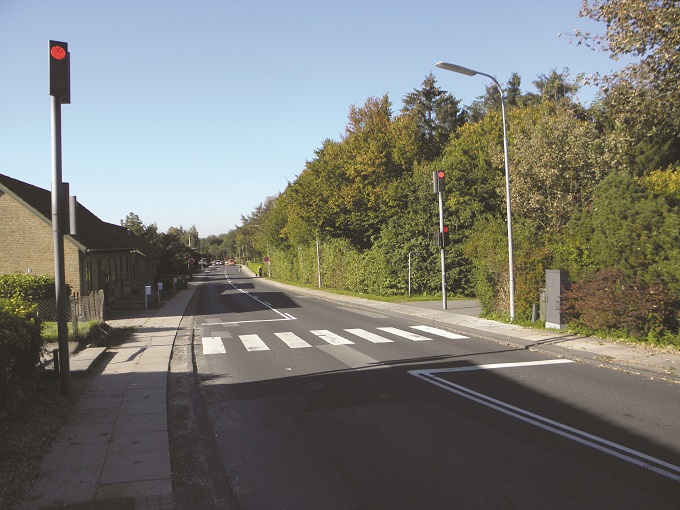
- The signal can be activated by a detector on the track so cyclists rarely have to stop for cross traffic on the road. Photo Troels Andersen
Sources
Cirkulære om etablering af dobbeltrettede cykelstier langs vej, CIR nr. 95 af 6. juli 1984.
Bestemmelser om opsætning af broautoværn og -rækværker, 2006



